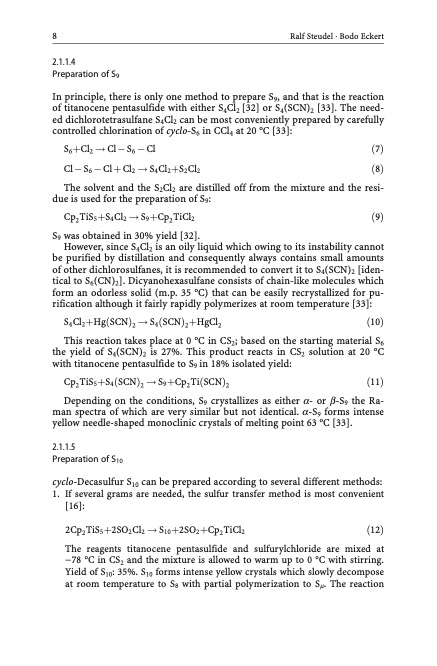
PDF Publication Title:
Text from PDF Page: 018
8 Ralf Steudel · Bodo Eckert 2.1.1.4 Preparation of S9 In principle, there is only one method to prepare S9, and that is the reaction of titanocene pentasulfide with either S4Cl2 [32] or S4(SCN)2 [33]. The need- ed dichlorotetrasulfane S4Cl2 can be most conveniently prepared by carefully controlled chlorination of cyclo-S6 in CCl4 at 20 C [33]: S6þCl2 !ClS6 Cl ð7Þ Cl S6 Cl þ Cl2 ! S4Cl2þS2Cl2 ð8Þ The solvent and the S2Cl2 are distilled off from the mixture and the resi- due is used for the preparation of S9: Cp2TiS5þS4Cl2 ! S9þCp2TiCl2 ð9Þ S9 was obtained in 30% yield [32]. However, since S4Cl2 is an oily liquid which owing to its instability cannot be purified by distillation and consequently always contains small amounts of other dichlorosulfanes, it is recommended to convert it to S4(SCN)2 [iden- tical to S6(CN)2]. Dicyanohexasulfane consists of chain-like molecules which form an odorless solid (m.p. 35 C) that can be easily recrystallized for pu- rification although it fairly rapidly polymerizes at room temperature [33]: S4Cl2þHgðSCNÞ2 ! S4ðSCNÞ2þHgCl2 ð10Þ This reaction takes place at 0 C in CS2; based on the starting material S6 the yield of S4(SCN)2 is 27%. This product reacts in CS2 solution at 20 C with titanocene pentasulfide to S9 in 18% isolated yield: Cp2TiS5þS4ðSCNÞ2 ! S9þCp2TiðSCNÞ2 ð11Þ Depending on the conditions, S9 crystallizes as either a- or b-S9 the Ra- man spectra of which are very similar but not identical. a-S9 forms intense yellow needle-shaped monoclinic crystals of melting point 63 C [33]. 2.1.1.5 Preparation of S10 cyclo-Decasulfur S10 can be prepared according to several different methods: 1. If several grams are needed, the sulfur transfer method is most convenient [16]: 2Cp2TiS5þ2SO2Cl2 ! S10þ2SO2þCp2TiCl2 ð12Þ The reagents titanocene pentasulfide and sulfurylchloride are mixed at 78 C in CS2 and the mixture is allowed to warm up to 0 C with stirring. Yield of S10: 35%. S10 forms intense yellow crystals which slowly decompose at room temperature to S8 with partial polymerization to Sm. The reactionPDF Image | Topics in Current Chemistry

PDF Search Title:
Topics in Current ChemistryOriginal File Name Searched:
Elemental-Sulfur-und-Sulfur-Rich-Compounds-I.pdfDIY PDF Search: Google It | Yahoo | Bing
Sulfur Deposition on Carbon Nanofibers using Supercritical CO2 Sulfur Deposition on Carbon Nanofibers using Supercritical CO2. Gamma sulfur also known as mother of pearl sulfur and nacreous sulfur... More Info
CO2 Organic Rankine Cycle Experimenter Platform The supercritical CO2 phase change system is both a heat pump and organic rankine cycle which can be used for those purposes and as a supercritical extractor for advanced subcritical and supercritical extraction technology. Uses include producing nanoparticles, precious metal CO2 extraction, lithium battery recycling, and other applications... More Info
| CONTACT TEL: 608-238-6001 Email: greg@infinityturbine.com | RSS | AMP |